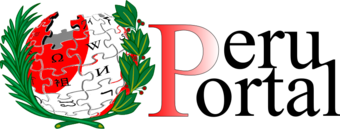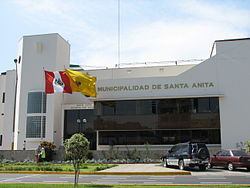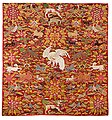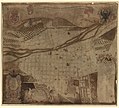Portal:Peru
Introduction
Peru, officially the Republic of Peru, is a country in western South America. It is bordered in the north by Ecuador and Colombia, in the east by Brazil, in the southeast by Bolivia, in the south by Chile, and in the south and west by the Pacific Ocean. Peru is a megadiverse country, with habitats ranging from the arid plains of the Pacific coastal region in the west, to the peaks of the Andes mountains extending from the north to the southeast of the country, to the tropical Amazon basin rainforest in the east with the Amazon River. Peru has a population of over 32 million, and its capital and largest city is Lima. At 1,285,216 km2 (496,225 sq mi), Peru is the 19th largest country in the world, and the third largest in South America. Peruvian territory was home to several cultures during the ancient and medieval periods, and has one of the longest histories of civilization of any country, tracing its heritage back to the 10th millennium BCE. Notable pre-colonial cultures and civilizations include the Caral–Supe civilization (the earliest civilization in the Americas and considered one of the cradles of civilization), the Nazca culture, the Wari and Tiwanaku empires, the Kingdom of Cusco, and the Inca Empire, the largest known state in the pre-Columbian Americas. The Spanish Empire conquered the region in the 16th century and Charles V established a viceroyalty with the official name of the Kingdom of Peru that encompassed most of its South American territories, with its capital in Lima. Higher education started in the Americas with the official establishment of the National University of San Marcos in Lima in 1551. Peru's population includes Mestizos, Amerindians, Europeans, Africans and Asians. The main spoken language is Spanish, although a significant number of Peruvians speak Quechuan languages, Aymara, or other Indigenous languages. This mixture of cultural traditions has resulted in a wide diversity of expressions in fields such as art, cuisine, literature, and music. (Full article...) Entries here consist of Good and Featured articles, which meet a core set of high editorial standards.
 The guinea pig or domestic guinea pig (Cavia porcellus), also known as the cavy or domestic cavy (/ˈkeɪvi/ KAY-vee), is a species of rodent belonging to the genus Cavia, family Caviidae. Breeders tend to use the name "cavy" for the animal, but "guinea pig" is more commonly used in scientific and laboratory contexts. Despite their name, guinea pigs are not native to Guinea, nor are they closely related to pigs. Instead, they originated in the Andes region of South America, where wild guinea pigs can still be found today. Studies based on biochemistry and DNA hybridization suggest they are domesticated animals that do not exist naturally in the wild, but are descendants of a closely related cavy species such as C. tschudii. Originally, they were domesticated as livestock (source of meat) in the Andean region and are still consumed in some parts of the world. In Western society, the guinea pig has enjoyed widespread popularity as a pet since its introduction to Europe and North America by European traders in the 16th century. Their docile nature, friendly responsiveness to handling and feeding, and the relative ease of caring for them have continued to make guinea pigs a popular choice of household pets. Consequently, organizations devoted to the competitive breeding of guinea pigs have been formed worldwide. Through artificial selection, many specialized breeds with varying coat colors and textures have been selected by breeders. (Full article...) Selected image Photo credit: Ericbronder
The district of Santa Anita is one of 43 districts in the city of Lima, which are administered by the Metropolitan Lima Municipal Council. Each district has its own council and mayor (Spanish: Municipalidad distrital). The town hall in each district is the seat of the district council. (more...) Selected battleThe Colombia-Peru War (September 1, 1932 - May 24, 1933) was an armed conflict between the Republic of Colombia and the Republic of Peru. The War was the result of dissatisfaction with the Salomón-Lozano Treaty and the imposition of heavy tariffs on sugar and started with an internal insurrection in Peru, a civilian takeover of the city Iquitos. On the first of september President Luis Miguel Sánchez dispatched two regiments of the Peruvian Army to Leticia and Tarapacá, both Peruvian settlementes in the Amazonas Region in present day southern Colombia. (more...) In this month
General imagesThe following are images from various Peru-related articles on Wikipedia.
Selected article -Machu Picchu is a 15th-century Inca citadel located in the Eastern Cordillera of southern Peru on a mountain ridge at 2,430 meters (7,970 ft). Often referred to as the "Lost City of the Incas", it is the most familiar icon of the Inca Empire. It is located in the Machupicchu District within the Urubamba Province above the Sacred Valley, which is 80 kilometers (50 mi) northwest of the city of Cusco. The Urubamba River flows past it, cutting through the Cordillera and creating a canyon with a subtropical mountain climate. The Inca civilization had no written language and following the first encounter by the Spanish soldier Baltasar Ocampo, no Europeans are recorded to have visited the site from the late 16th century until the 19th century. As far as historical knowledge extends, there are no existing written records detailing the site during its period of active use. The leading theory is that Machu Picchu was a private city for Incan royalty. The names of the buildings, their supposed uses, and their inhabitants, are the product of modern archaeologists based on physical evidence, including tombs at the site. Machu Picchu was built in the classical Inca style, with polished dry-stone walls. Its three primary structures are the Temple of the Sun, the Temple of the Three Windows, and the Intihuatana. From 1929 to 1971, Machu Picchu underwent extensive restoration and conservation work, including structural stabilization and artifact excavation, driven by government initiatives and research expeditions. Most recent archaeologists believe that Machu Picchu was constructed as an estate for the Inca emperor Pachacuti (1438–1472). The Inca built the estate around 1450 but abandoned it a century later, at the time of the Spanish conquest. According to the new AMS radiocarbon dating, it was occupied from c. 1420–1532. Historical research published in 2022 claims that the site was probably called Huayna Picchu by the Inca people themselves, as it exists on the smaller peak of the same name. (Full article...) Did you know (auto-generated) -
CategoriesRelated portalsSelected quote -
Peruvian-born American author Carlos Castaneda
Basic facts & figuresMore did you know...
Peru TopicsRecognized content
Featured articlesFeatured listsGood articles
WikiProjectsThings you can do
New articlesThis list was generated from these rules. Questions and feedback are always welcome! The search is being run daily with the most recent ~14 days of results. Note: Some articles may not be relevant to this project.
Rules | Match log | Results page (for watching) | Last updated: 2024-11-22 21:49 (UTC) Note: The list display can now be customized by each user. See List display personalization for details.
Associated WikimediaThe following Wikimedia Foundation sister projects provide more on this subject:
Discover Wikipedia using portals | |||||||||||||||



















































